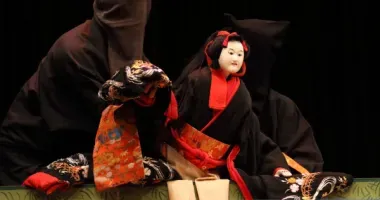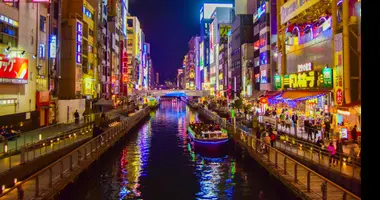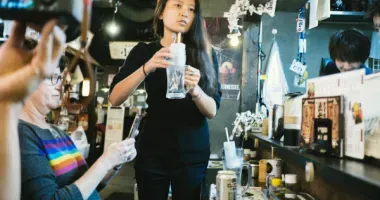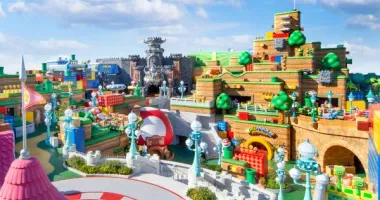Osaka Castle
- Features
- History
- Osaka Castle Museum
- Castle Grounds
- Osaka Castle Park
- Shopping and Dining
- Nearby
- Accommodation
- Access
- Japanese Castles
Osaka Castle

Osaka's castle is one of the most impressive in Japan
Osaka Castle is Osaka's most imposing historical monument, with roots stretching back to the activities of 15th century warrior monks who came from nearby Kyoto to set up a base here.
Osaka Castle is located in Kyobashi, a business center slightly east that is also one of Osaka's most uncompromisingly modern districts. From the castle, the surrounding area looks like a city planner's model landscape of lawns, forest, great bowls, domes, and gleaming, mirror-clad buildings. From the highrises, the castle seems an age away, an age in which the city itself was born.

Osaka Castle is one of the largest castles in Japan with huge stone walls
Set in the 105-hectare (260 acre) Osaka-Jo Koen (Osaka Castle Park), the castle retains its original high, sloping stone walls, surrounded by moats. These are said to be the biggest stone defense walls remaining in Japan. They and the wide moats at their base are an imposing spectacle, and help make Osaka Castle one of the city's most photogenic sightseeing spots.
Osaka Castle is now home to a modern museum charting the life and achievements of Toyotomi Hideyoshi, the warlord who, following the defeat of the monks, built the first real castle here in 1583. The surrounding park is a playground for Osaka's citizens and a venue for impromptu weekend musical performances.
Features
Compared to the skyscrapers that surround it, the castle, renovated again in 1997, makes up in svelte lavishness for what it lacks in height. The famous tiled roof of the main tower is the first thing visible, the ridges culminating in cornices depicting great leaping golden carps.
The extensive black facings beneath the uppermost roof bear an array of nature-inspired designs done in gold.
After a couple more minutes' walk the walls suddenly become visible. They tower over the outer moats, which, unlike the inner moats, are full of unkempt greenery rather than water, and are composed of a variety of masonry styles.
Part of the wall overlooking the west outer moat, for example, has its stones laid in subtle oval mosaic patterns not immediately obvious, but which allow for a bit of imaginative eye-play when discovered.

Osaka Castle's impressive stone walls

Boat trip on the moat
History
From its beginnings as a fortress of warrior monks in the 15th century, Osaka Castle has a long and complicated history, being built, destroyed and rebuilt many times over. The first construction of a castle here was by warlord Toyotomi Hideyoshi in 1583, on the grounds of the destroyed Honganji Temple. Toyotomi intended it to become the base from which he would rule a united Japan. In 1662 the Main Tower was struck by lightning, and was razed in the ensuing fire. Although many other buildings dotting the complex were rebuilt, it was not until 1931 that the citizens of Osaka funded the rebuilding of the Main Tower, this time in ferroconcrete.
In World War Two, much of the castle was damaged by bombing. The most recent reconstruction was in 1997, when Osaka Castle was rebuilt using modern materials, and restored to much what it looked like in its Edo period heyday, when it was counted among Japan's three great castles.

The walls of the castle with the high rise buildings of central Osaka in the background

Osaka Castle seen against a dramatic sunset
Read more on the history of Osaka Castle
Osaka Castle Museum
Enter the main tower of Osaka Castle and you are in the Osaka Castle Museum, with its eight floors devoted mainly to exhibits describing Hideyoshi Toyotomi and his era. That is, displays here are centered on the Azuchi-Momoyama period of Japanese history. The museum has an extensive collection of over 10,000 historical items. As well as warrior-related exhibits of armor, swords, and other weapons, there is an elaborate folding screen depicting the 1615 Summer War that destroyed Hideyoshi's castle, intricate works of decorative art, contemporary portraits of Hideyoshi Toyotomi and other warlords, as well as extant correspondence penned in their own hand. Hologram-enhanced peep shows also give insights into how life was lived in and around Osaka Castle in the 16th century.
A visit to the Museum culminates in the 8th floor observation deck that offers one of the finest panoramic views of Osaka, enhanced by a wide open green foreground.
Entry to the Museum (main tower) is 600 yen, free for children.
Hours: 9 a.m. to 5 p.m. (last admission 4:30 p.m.), 7 days a week

Former Osaka Guest House (Geihinkan)
Castle Grounds
The main tower housing the museum is just one of the many structures that make up the grounds of Osaka Castle. The northeast Aoyamon Gate, the southern Sakuramon Gate and the western Otemon Gate are structures in their own right. There are also various turrets on the perimeter, the Hokoku Shrine, the Kinzo treasure house, and the Shudokan martial arts training hall.
The Nishinomaru Garden just west of the castle tower is a 6-hectare garden, containing various old structures, including the Former Osaka Guest House (Geihinkan). The Hoshoan tea house is a major attraction here, too. The garden requires a small separate entrance fee.
Osaka Castle Park
Osaka Castle Park, of which the castle itself forms a part, is a big green space that caters to numerous pursuits. Nature lovers will appreciate the Plum Grove just to the east of the castle; the Peach Grove, outside the moat, at the north edge of the park; and the Forest Park at the south-east of the park.
There are archery, baseball and playground spaces at the north-east of the park.
At the height of springtime Osaka Castle Park is a raucous cherry blossom viewing (hanami) idyll with family, friends and colleagues drinking in circles under boughs of cheery blossom.
At the end of July the Okawa River to the north-west of the castle is the venue for the huge Osaka Tenjin-Matsuri Festival. The climax of the festival is a procession down the river of scores of boats to the thunderous fanfare of a fireworks display.
Osaka Jo Hall is a massive modern indoor stadium at the north-east of the park seating over 16,000 that hosts everything from rock concerts to judo championships.
The Osaka International Peace Center is located near the Morinomiya Station corner of Osaka Castle Park.
Finally, personalized and comprehensive guidance around Osaka Castle Park is available free of charge from the Osaka Volunteer Tour Guides who can be contacted Monday to Friday, 10 a.m. to 5 p.m., at 06 6635 3018.
Shopping and Dining
Osaka Jokamachi is a more recent dining and shopping experience at the eastern edge of the park, between Osaka Jo Hall and Osakajokoen Station. Here you can also try your hand at being a virtual reality ninja. Great fun!
Jo-Terrace Osaka is a shopping complex right next to Osaka Jokamachi. Jo-Terrace Osaka is made up of 8 different "terraces" containing dozens of mainly restaurants and cafes.
Nearby
The Osaka Museum of History is near the south-western corner of Osaka Castle Park, near Tanimachi 4-chome Station.
Accommodation Near Osaka Castle

Here are three recommended hotels near Osaka Castle Park, covering all budgets.
Hotel New Otani Osaka directly overlooks Osaka Castle Park, and is just a short walk away across a bridge over the Daini Neya River. This hotel has no less than 13 dining options on site serving all sorts of cusine from around the globe. And it is only a few minutes' walk from nearby Osaka Jokamachi and Jo-Terrace Osaka, making the New Otani ideally located for a convenient, relaxed and scenic stay. Only five minutes walk to the nearest subway station: Osakajokoen Station.
Hotel the Lutheran is at the southwest corner of Osaka Castle Park, and a 1-minute walk from Tanimachi Yonchome Station Exit 1B. Combining quality with convenience and quietness, this clean, efficient hotel has decent-sized rooms and a good breakfast. The rooms come with all the amenities: toiletries, tea and coffee making facilities, television, telephone, bathroom, etc. for a reaonable price.
Guest House Sora Osaka is about 1km south of Osaka Castle, but is both ecnomical and highly rated for providing guests with top-notch facilities and a comfortable space for all guests to enjoy. Each room has a private bathroom with bidet and hairdryer, microwave, and some rooms have a balcony. Non-smoking rooms are available. A great balance of convenience and economy not far south of Osaka Castle.
Osaka Castle Access
The nearest station to Osaka Castle is Osakajo-koen on the JR Osaka Loop Line. Other nearby stations to Osaka Castle Park include Morinomiya on the Osaka Loop Line and Chuo and Nagahori Tsurumi-ryokuchi lines of the Osaka Subway, Osaka Business Park on the Nagahori Tsurumi-ryokuchi Line, Tanimachi 4-chome Station on the Chuo Line and to the west Temmabashi Station on the Tanimachi Line and Keihan Line, which connects to Kyoto.
The Aqua Liner has a pier at the north-east of Osakajo Koen, very near Osakajokoen Station and just across the river from Osaka Business Park Station.
Osaka Castle
1-1, Osakajo
Chuo-ku
Osaka
540-0002
Tel: 06 6941 3044
Osaka Castle map
Hours: 9 am-5 pm
Admission: 600 yen

View of Osaka Castle from the Osaka Museum of History
Book Hotel Accommodation in Osaka near Osaka Castle
Books on Japanese Castles
Osaka Castle: read a history of Osaka Castle and a description of things to do and see on a visit to Osaka Castle and the surrounding park.























